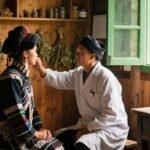Mengchong Dang (Low Back Pain)
Overview
In Miao medicine, low back pain is called Mengchong Dang, denoting pain on one or both sides of the lumbar region.
In TCM, lumbar pain (“yaoji pain”) arises when external pathogens, internal injury, or trauma disrupt qi–blood circulation in the lower back, leading to pain along the spine or beside it.
In Western medicine, conditions such as lumbar myofascitis, ankylosing spondylitis, vertebral osteophytes, lumbar disc disorders, muscle strain, and certain visceral diseases presenting with back pain may be approached using similar pattern differentiation.
Huhoujipeng · Miao Classification
Mengchong Dang is a minor disorder divided into two patterns: cold–meridian lumbar pain and heat–meridian lumbar pain. Pain often correlates with temperature changes or overexertion.
Aiduojiang · Causes
Wind toxin invades and lodges in the meridians; cold toxin congeals qi–blood; damp toxin obstructs flow; trauma or overwork injures muscles and blood, causing qi stagnation and blood stasis.
Gengduomeng · Pathogenesis
Pathogens block meridians, causing qi–blood disharmony. Cold stagnation produces cold–meridian pain; heat invasion produces heat–meridian pain. Trauma leads to stasis and chronic pain.

Diagnostic Key Points
Diagnosis
(1) Acute: sudden lumbar pain worsened by slight movement, with tender spots beside the spine.
(2) Chronic: lingering dull or aching pain aggravated by poor posture, overwork, or weather changes.
(3) Often a history of damp–cold exposure, trauma, or overstrain.
Related Tests
CBC, ASO titer, ESR, rheumatoid factor to exclude rheumatic disease; lumbar and sacroiliac X-ray or CT for structural changes; urine and pelvic exams to exclude visceral causes.
Differential Diagnosis
Chongdang Ge (Joint Bi) presents with joint pain, swelling, deformity, and limited motion—distinguished by joint involvement rather than isolated lumbar pain.
Pattern Differentiation & Treatment
Cold–Meridian Lumbar Pain
Manifestations: Cold, tight lumbar pain worse in cold or rain; relief with heat; stiffness, weakness, dizziness, tinnitus, insomnia.
Meridian: Cold meridian, cold disease.
Principle: Nourish blood and kidneys (bu xue bu shen), dispel wind–cold (qu feng san han), warm channels and relieve pain (wen jing zhi tong).
Formula (wine-soaked decoction):
Qianshicao (Rubia cordifolia, qian cao) 30g
Xu Changqing (Radix Changqing, xu chang qing) 18g
Xiao Xixin (Asarum leaf, xi xin) 18g
Mugua (Papaya, mu gua) 25g
Xuduan (Dipsacus root, xu duan) 22g
Qi Ye Lian (Paris polyphylla, qi ye lian) 60g
Daxueteng (Sargentodoxa, da xue teng) 25g
Ciwu Jia (Acanthopanax, ci wu jia) 15g
Heat–Meridian Lumbar Pain
Manifestations: Fixed stabbing lumbar pain, bitter mouth, irritability, scant yellow urine.
Meridian: Heat meridian, heat disease.
Principle: Drain dampness (chu shi), invigorate blood (huo xue), relieve pain (zhi tong).
Formula (wine-soaked, internal & external):
Oxalis (Oxalis corniculata, cu jiang cao) 15g
Zelan (Lycopus, ze lan) 12g
Jianxuefei (Sargentodoxa, jian xue fei) 10g
Chi Shao (Red Peony Root, chi shao) 10g
Daxueteng (Sargentodoxa vine, da xue teng) 10g
Yanwanzi (Dioscorea yam, yan wan zi) 15g
Prevention & Care
Maintain correct posture; avoid heavy lifting and damp cold.
Acute pain: rest and recover; chronic: warm support, moderate exercise (massage, Tai Chi).
Avoid overwork, exposure to wind–cold, and damp environments.
Disclaimer:
This article is provided solely for the cultural and educational study of traditional medicine. It should not be construed as medical diagnosis or (used in traditional contexts). Before applying any of the therapies described above, you must consult a licensed physician in your jurisdiction.



Leave a Reply